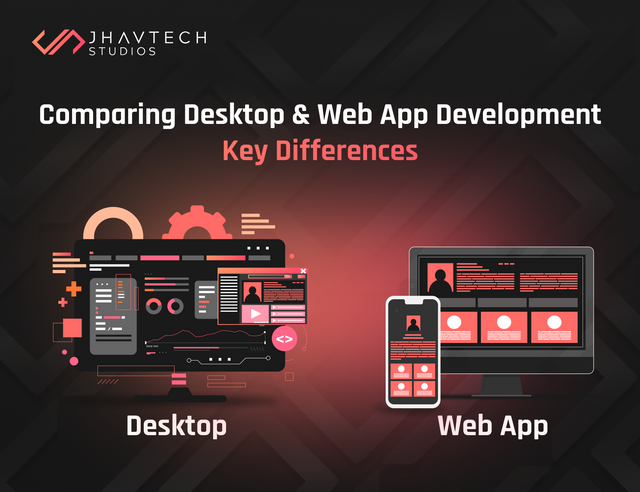Comparing Desktop and Web App Development: Key Differences
.png)
In today's tech-driven world, the debate between desktop app development and web app development is more relevant than ever. Whether you're a developer or a business owner, understanding the nuances of each can significantly impact your project's success. In this article, we'll delve into the key differences between desktop and web app development, covering various aspects such as performance, user experience, development costs, and more.
Understanding Desktop App Development
Desktop app development refers to creating software applications that run natively on a desktop operating system like Windows, macOS, or Linux. These applications are installed directly onto the user's computer and can take full advantage of the system's hardware and resources.
Advantages of Desktop Apps
One of the primary advantages of desktop apps is their performance. Since they run locally on a user's device, they can leverage the full power of the hardware, resulting in faster and more responsive experiences. This is particularly crucial for resource-intensive applications such as video editing software, 3D rendering programs, and high-end gaming.
Additionally, desktop apps can operate offline, providing uninterrupted access to the application's features without relying on an internet connection. This is a significant benefit for users in areas with unreliable connectivity or those who require access to their tools at all times.
Challenges in Desktop App Development
However, desktop app development also comes with its own set of challenges. One major hurdle is platform dependency. Developers often need to create separate versions of their applications for different operating systems, which can be time-consuming and costly. Furthermore, ensuring compatibility across various hardware configurations can be complex.
Understanding Web App Development
Web app development, on the other hand, involves creating applications that run in a web browser. These applications are accessed via the Internet and do not require installation on the user's device. Web apps are typically built using technologies like HTML, CSS, JavaScript, and backend frameworks such as Node.js, Ruby on Rails, or Django.
Advantages of Web Apps
One of the standout advantages of web apps is their cross-platform compatibility. Since web apps run in browsers, they can be accessed from any device with an internet connection, regardless of the operating system. This significantly broadens the potential user base and simplifies the development process, as developers only need to maintain one codebase.
Moreover, web apps offer easier updates and maintenance. Updates are deployed on the server side, meaning users always have access to the latest version without needing to manually download and install updates. This ensures a consistent user experience and reduces the burden on users to keep their software up to date.
Challenges in Web App Development
Despite their advantages, web apps also face challenges. Performance can be a significant issue, particularly for applications that require intensive processing or low-latency interactions. While advancements in web technologies have improved performance, web apps still generally lag behind desktop apps in this regard.
Additionally, web apps rely heavily on a stable internet connection. Without it, users may experience downtime or limited functionality, which can be a critical drawback for applications that require constant accessibility.
Security Considerations
Security is a crucial aspect of both desktop and web app development, but the approaches differ. Desktop apps, being locally installed, can be more secure in terms of data storage and offline operation. However, they are susceptible to security vulnerabilities related to the host operating system and potential malware attacks.
Web apps, conversely, need robust server-side security measures to protect data transmitted over the internet. SSL/TLS encryption, secure authentication methods, and regular security updates are essential to safeguard against cyber threats. While web apps can benefit from centralized security updates, they are also attractive targets for hackers due to their online nature.
User Experience and Interface Design
.png)
When it comes to user experience and interface design, both desktop and web apps have unique considerations. Desktop apps can offer highly customized and optimized interfaces that take full advantage of the operating system's capabilities. This can result in a more seamless and integrated user experience.
Web apps, however, need to be designed with responsiveness in mind. They must adapt to various screen sizes and resolutions, ensuring usability across desktops, tablets, and smartphones. Modern web development frameworks and libraries, such as React and Angular, provide tools to create responsive and interactive interfaces that can rival desktop applications.
Development Costs and Timeframes
The cost and time required for development can vary significantly between desktop and web apps. Desktop app development often requires more resources upfront due to the need for platform-specific versions and extensive testing across different hardware configurations. This can lead to higher initial development costs and longer timeframes.
Web app development, while generally more cost-effective due to a single codebase and easier deployment, can still incur significant expenses, especially when considering ongoing server maintenance, hosting costs, and security measures. However, the ability to reach a wider audience with a single application can offset these costs in the long run.
Scalability and Futureproofing
Scalability is another critical factor to consider. Web apps are inherently more scalable, as they can handle increasing user loads by adjusting server resources and optimizing backend performance. Cloud-based infrastructure and services make it easier to scale web applications dynamically.
Desktop apps, on the other hand, can face limitations in scalability due to hardware dependencies and the need for individual installations. However, they can still be scaled through updates and optimizations tailored to the specific hardware configurations of their user base.
Final Thoughts…
In conclusion, the choice between desktop and web app development depends on various factors, including performance requirements, user base, development resources, and scalability needs. Desktop apps offer superior performance and offline capabilities, making them ideal for resource-intensive tasks and environments with unreliable internet connectivity. Conversely, web apps provide cross-platform compatibility, easier maintenance, and scalability, making them suitable for a broader audience and dynamic user loads.
Ultimately, the decision should be guided by the specific goals and constraints of the project. By understanding the key differences and weighing the pros and cons of each approach, developers and businesses can make informed choices that align with their objectives and deliver the best possible user experience.